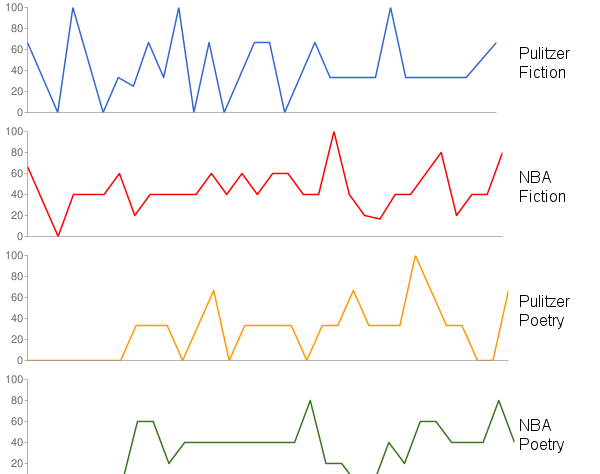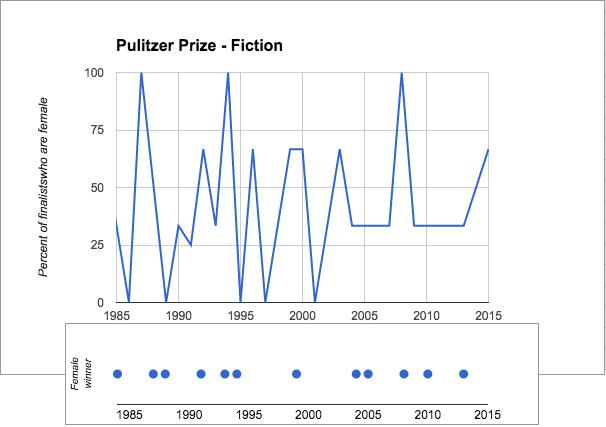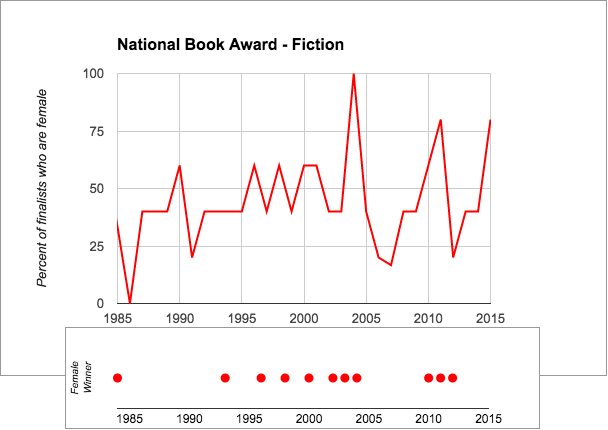Patterns in the Pulitzer Prize and National Book Award for Fiction and Poetry
The Pulitzer Prize and National Book Award are two of the most prestigious awards in American literature. Pulitzer Prizes, established in 1917, are awarded mostly for journalism by a 20-person board mostly populated by people from the profession, but the board also presents several literary awards. On the other hand, the National Book Awards originated in 1935 as a set of prizes created and determined by members of the publishing industry, before taking on its current name in 1950 and ultimately becoming administered by a new National Book Foundation in 1988; the focus of these awards, then, is entirely literary. Both sets of literary awards are presented only to American citizens.
Given the prominence of these awards in the world of American literature, let's see what patterns we can observe in them over the last several decades.
*
Overlap between Pulitzer Prize and National Book Award finalists
These diagrams show the overlap between finalists for the Pulitzer Prize and National Book Award each year. Each block represents a book. Green blocks are finalists for the Pulitzer from that year, orange blocks are finalists for the National Book Award, and purple blocks are books that were finalists for both prizes. If a block has a 'w' inside, that means the same book was the winner of both prizes that year.
| 1984 | | | | | | | | | | | | | |
| 1985 | | | | | | | | | | | | | |
| 1986 | | | | | | | | | | | | | |
| 1987 | | | | | | | | | | | | | |
| 1988 | | | | | | | | | | | | | |
| 1989 | | | | | | | | | | | | | |
| 1990 | | | | | | | | | | | | | |
| 1991 | | | | | | | | | | | | | |
| 1992 | | | | | | | | | | | | | |
| 1993 | | | | | | w | | | | | | | |
| 1994 | | | | | | | | | | | | | |
| 1995 | | | | | | | | | | | | | |
| 1996 | | | | | | | | | | | | | |
| 1997 | | | | | | | | | | | | | |
| 1998 | | | | | | | | | | | | | |
| 1999 | | | | | | | | | | | | | |
| 2000 | | | | | | | | | | | | | |
| 2001 | | | | | | | | | | | | | |
| 2002 | | | | | | | | | | | | | |
| 2003 | | | | | | | | | | | | | |
| 2004 | | | | | | | | | | | | | |
| 2005 | | | | | | | | | | | | | |
| 2006 | | | | | | | | | | | | | |
| 2007 | | | | | | | | | | | | | |
| 2008 | | | | | | | | | | | | | |
| 2009 | | | | | | | | | | | | | |
| 2010 | | | | | | | | | | | | | |
| 2011 | | | | | | | | | | | | | |
| 2012 | | | | | | | | | | | | | |
| 2013 | | | | | | | | | | | | | |
| 2014 | | | | | | | | | | | | | |
| 2015 | | | | | | | | | | | | | |
Prizes for fiction, 1984-2015
The National Book Award for Fiction has been awarded in some form since 1935. However, that form has changed over time. For example, in early years the winner would be announced alongside many runners up (or none), and in some years multiple winners split the award. From 1980-1983, there were separate awards for hardcovers and paperbacks. And there have at times been additional awards for specific genres of fiction (e.g. science fiction, western). At present, there's an award for "young people's literature" in addition to fiction. These visualization only considers the finalists and winner of the general "fiction" prize awarded from 1984 to the present. This comprises 1 winner and 2 finalists through 1986 and 1 winner and 4 finalists after that.
The Pulitzer Prize for Fiction, on the other hand, has been awarded in a fairly consistent manner since 1917 (though the prize was for the "Novel" specifically through 1947), with several finalists also announced since 1980. The Pulitzer Prize for books published in a given year is awarded in the following year, so on this website books' publishing-year is used to match with the National Book Awards (e.g. the 2015 row represents finalists for the "2016 Pulitzer Prize"). If in any year a majority of the 20-person Pulitzer Prize Board does not agree on a winner, no award is given (for example, this occurred for the 2012 Pulitzer Prize—represented in the 2011 row here).
There has often been some, but not much, overlap between the finalists of the two prizes. The finalists for each are chosen by a small jury—3 to 7 people for the Pulitzer, and 5 panelists (who also choose the winner) for the National Book Award. We can notice that in 5 out of the last 6 years there has been no overlap at all. Annie Proulx's The Shipping News (1993) is the only book to win both awards in the last several decades.
| 1991 | | | | | | | | | | | | |
| 1992 | | | | | | | | | | | | |
| 1993 | | | | | | | | | | | | |
| 1994 | | | | | | | | | | | | |
| 1995 | | | | | | | | | | | | |
| 1996 | | | | | | | | | | | | |
| 1997 | | | | | | | | | | | | |
| 1998 | | | | | | | | | | | | |
| 1999 | | | | | | | | | | | | |
| 2000 | | | | | | | | | | | | |
| 2001 | | | | | | | | | | | | |
| 2002 | | | | | | | | | | | | |
| 2003 | | | | | | | | | | | | |
| 2004 | | | | | | | | | | | | |
| 2005 | | | | | | | | | | | | |
| 2006 | | | | | | | | | | | | |
| 2007 | | | | | w | | | | | | | |
| 2008 | | | | | | | | | | | | |
| 2009 | | | | | | | | | | | | |
| 2010 | | | | | | | | | | | | |
| 2011 | | | | | | | | | | | | |
| 2012 | | | | | | | | | | | | |
| 2013 | | | | | | | | | | | | |
| 2014 | | | | | | | | | | | | |
| 2015 | | | | | | | | | | | | |
Prizes for poetry, 1991-2015
The prizes for poetry have similar histories as their fiction counterparts; some form of the Pulitzer has been awarded since 1918 with finalists being announced from 1980 onward, and the National Book Award has been given since 1950, with a hiatus from 1984-1990. Therefore 1991 is the earliest year from which we have continuous finalist data from both.
As we saw with the fiction prizes, there is similarly little overlap between the poetry prizes. Again, there has been none in 5 out of the last 6 years, and the lack of overlap from 2001-2006 also stands out. Robert Haas won both awards for Time and Materials (2007).
*
Gender breakdown of Pulitzer Prize and National Book Award finalists
These graphs explore the gender of prize finalists (and winners) over the past 31 years. As Western literature has historically centered on a male-written canon, the visualizations are presented as the precentage of finalists in any given year that are female.
These precentages were generated by an algorithm that guesses male/female gender based on their first name and that name's gender distribution based on Social Security Administration Statistics; these guesses were augmented by manual checking. However, the classifications could contain mistakes, and they certainly operate in a gender-binary system and thus may not provide a full or rich description of gender representation over time. They are a simplification, but perhaps they can provide a glimpse into the voice women have had in America's literary culture.
Each graph below shows the percentage of finalists in any given year that were women. (The graph above contains a succinct summary of each of these graphs, for the sake of comparison.) They are also accompanied by a 1D scatter plot showing in which years women were winners.
There is no clear trend of "progress" from the 1980s to present, though it has become rarer in recent years to have slates of finalists with 0 women in them. In general, the graphs tend to hover slightly below parity, but with plenty of volatility in either direction from year to year. We can note that the National Book Awards' gender breakdown tends to vary less than that of the Pulitzers, perhaps in part due to the fact that there are more finalists in any given year. We can also observe that poetry has in general had fewer women finalists than fiction.
Although robust finalist data is not available for previous years, it would be interesting to explore winner data reaching back earlier in the twentieth century.




